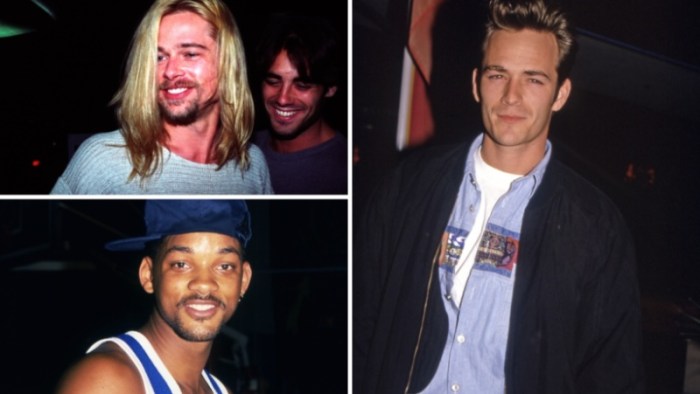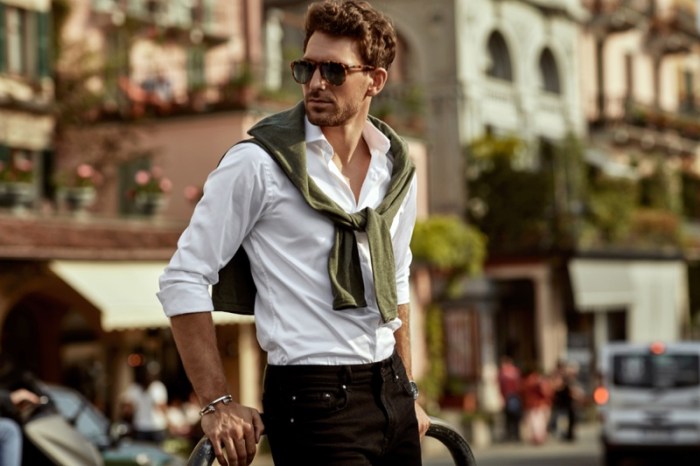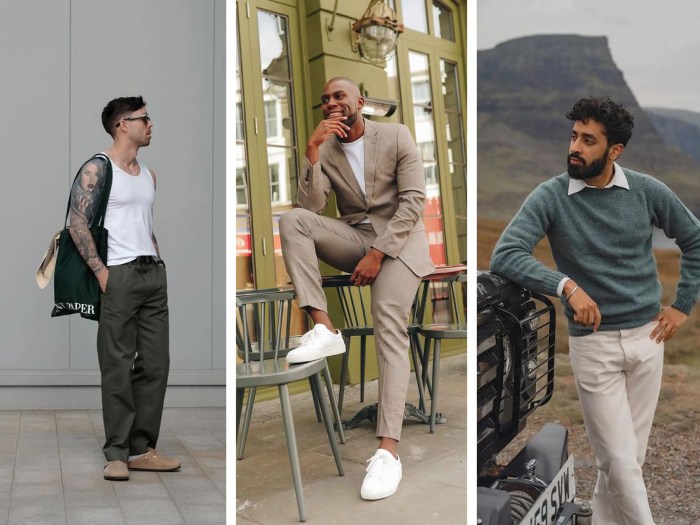Mens Fashion Influencer A Style Guide
Defining the Mens Fashion Influencer Landscape
Mens fashion influencer – The men’s fashion influencer landscape is incredibly diverse, encompassing a wide spectrum of styles, reach, and platform preferences. Understanding this diversity is crucial for both aspiring influencers and brands seeking collaborations.
Categorization of Men’s Fashion Influencers
Men’s fashion influencers can be categorized in several ways. Style encompasses everything from classic tailoring to streetwear, athleisure, and niche subgenres like workwear or sustainable menswear. Audience reach differentiates micro-influencers (smaller, highly engaged followings) from macro-influencers (large, broader audiences). Platform preference varies widely, with some focusing on Instagram, others on YouTube, TikTok, or a combination thereof. For example, a micro-influencer specializing in sustainable menswear might primarily use Instagram and blog posts to reach an environmentally conscious audience, while a macro-influencer focusing on mainstream trends could dominate on YouTube and TikTok.
Micro-Influencers vs. Macro-Influencers: A Comparison
Micro-influencers often cultivate stronger relationships with their followers due to higher engagement rates and a more personalized approach. Their content tends to be more authentic and relatable. Macro-influencers, on the other hand, boast wider reach but may experience lower engagement per post. Their strategies often involve leveraging sophisticated analytics and collaborating with larger brands. Both approaches are effective, depending on the overall marketing goals.
Characteristics of Successful Men’s Fashion Influencers
Successful men’s fashion influencers consistently demonstrate authenticity, strong visual presentation, a clear niche, consistent posting, and active community engagement. They understand their audience, build genuine connections, and adapt to evolving trends and platform algorithms. Conversely, less successful influencers may lack a defined niche, post inconsistently, or fail to interact meaningfully with their followers.
Content Creation Strategies of Mens Fashion Influencers
Effective content creation is paramount for men’s fashion influencers. This involves strategic use of diverse formats, high-quality visuals, and compelling storytelling.
Content Formats and Their Effectiveness
| Format | Pros | Cons | Example |
|---|---|---|---|
| Instagram Reels | High engagement, short-form video ideal for showcasing quick style tips and outfit ideas. | Requires concise messaging and visually appealing content; algorithm changes can impact reach. | A quick transition showcasing different ways to style a single blazer. |
| YouTube Videos | Allows for in-depth content, tutorials, and brand stories; can build a strong community. | Requires significant time and effort to produce high-quality videos; requires consistent uploading. | A detailed guide on how to build a capsule wardrobe for the fall season. |
| Blog Posts | Provides space for detailed product reviews, style guides, and personal narratives; good for . | Requires strong writing skills and consistent content creation; may have lower engagement than video formats. | A detailed review of a new line of sustainable men’s footwear. |
| TikTok Content | High viral potential; ideal for trend-driven content and short, catchy videos. | Highly competitive platform; algorithm-dependent; requires understanding of trending sounds and challenges. | A humorous video showcasing common men’s fashion mistakes. |
The Importance of High-Quality Visuals and Storytelling
High-quality visuals are essential for grabbing attention in a crowded online space. Professional photography or videography, good lighting, and aesthetically pleasing editing are crucial. Storytelling adds depth and personality, making the content more engaging and memorable. For example, a visually compelling Instagram post might showcase a stylish outfit against a stunning backdrop, accompanied by a caption that tells a personal story about the inspiration behind the look.
Sample Content Calendar
A sample content calendar for a men’s fashion influencer might include diverse themes for a month, such as:
- Week 1: Focus on fall fashion essentials.
- Week 2: Highlight a collaboration with a sustainable menswear brand.
- Week 3: Share styling tips for different body types.
- Week 4: Run a Q&A session with followers on Instagram Live.
Collaboration and Brand Partnerships: Mens Fashion Influencer
Brand partnerships are a key revenue stream for men’s fashion influencers. Understanding the different types and their effectiveness is essential for maximizing ROI.
Types of Brand Partnerships
Common partnership types include sponsored posts (featuring a brand’s product or service), affiliate marketing (earning a commission on sales generated through unique links), and brand ambassador roles (long-term collaborations involving representing a brand’s values and image). The choice depends on the influencer’s audience, brand alignment, and the campaign goals.
Effectiveness of Collaboration Strategies
Effectiveness is measured by audience engagement (likes, comments, shares), brand alignment (how well the brand fits the influencer’s image and values), and ultimately, sales or conversions generated. A well-executed campaign should show strong synergy between the influencer’s style and the brand’s message, resulting in increased brand awareness and positive consumer sentiment.
Potential Brand Partners for a Niche Influencer, Mens fashion influencer
A men’s fashion influencer specializing in sustainable menswear could partner with brands like Patagonia, Everlane, or other eco-conscious clothing companies. An athleisure influencer might collaborate with brands like Lululemon, Nike, or Adidas.
Audience Engagement and Community Building
Building a loyal and engaged following requires consistent effort and strategic interaction with the audience.
Strategies for Building a Loyal Following
Strategies include consistent high-quality content, responding to comments and messages promptly, running contests and giveaways, hosting live Q&A sessions, and creating opportunities for user-generated content. Building a strong community requires fostering a sense of belonging and actively engaging with followers on a personal level.
The Role of Interactive Content
Interactive content such as polls, Q&As, and contests encourages participation and strengthens the sense of community. It provides valuable feedback, allowing influencers to better understand their audience’s preferences and tailor their content accordingly.
Responding to Comments and Feedback
Responding to comments, both positive and negative, demonstrates engagement and professionalism. Positive comments should be acknowledged and appreciated. Negative feedback should be addressed constructively, showing empathy and a willingness to improve.
Measuring Success and Analyzing Performance

Source: thefashionisto.com
Measuring success requires tracking key performance indicators (KPIs) and analyzing the data to optimize future strategies.
Key Performance Indicators (KPIs)
- Engagement rate (likes, comments, shares)
- Reach (number of unique users who saw the content)
- Website traffic (clicks from social media posts)
- Conversion rate (sales or sign-ups generated from influencer marketing)
- Brand mentions and sentiment analysis
- Follower growth
Tracking and Analyzing Campaign Performance

Source: thefashionisto.com
Tools like social media analytics dashboards and website analytics platforms provide valuable data on engagement metrics and conversion rates. This data allows influencers to identify successful content formats, optimize posting times, and refine their strategies.
Using Data Analysis to Improve ROI
Analyzing data helps understand what resonates with the audience and what doesn’t. This informs content strategy, allowing influencers to create more engaging content and improve the overall return on investment (ROI) of their marketing efforts.
The Future of Mens Fashion Influencing
The men’s fashion influencer landscape is constantly evolving, driven by technological advancements and shifting social media trends.
Emerging Trends
Livestreaming is gaining popularity, offering a more interactive and immediate way to connect with followers. The integration of augmented reality (AR) and virtual reality (VR) technologies allows for immersive shopping experiences and personalized style recommendations. For example, an influencer could use AR to let followers virtually “try on” different outfits before purchasing.
Impact of Algorithm Changes

Source: shgcdn.com
Changes in social media algorithms continually impact reach and engagement. Influencers must adapt by understanding the latest algorithm updates and optimizing their content accordingly. This might involve experimenting with different content formats, using relevant hashtags, and engaging with followers more actively.
Prediction for the Future
In the next 5 years, we can expect to see a continued rise in niche influencers, a greater emphasis on authenticity and transparency, and a more sophisticated use of data analytics to optimize marketing efforts. The integration of AR/VR and the continued growth of livestreaming will reshape the way brands and consumers interact with fashion influencers.
Questions Often Asked
What are the typical income streams for a men’s fashion influencer?
Income streams typically include sponsored posts, affiliate marketing commissions, brand ambassador deals, and potentially merchandise sales.
How important is authenticity in men’s fashion influencing?
Authenticity is paramount. Audiences value genuine style and relatable content; inauthenticity can quickly damage credibility and engagement.
What are some common mistakes new men’s fashion influencers make?
Common mistakes include inconsistent posting, neglecting audience engagement, focusing solely on sales, and ignoring analytics.
How can I find suitable brand partners?
Reach out directly to brands aligning with your niche and aesthetic, or use influencer marketing platforms to connect with potential collaborators.





















